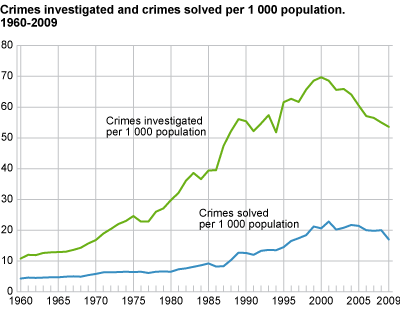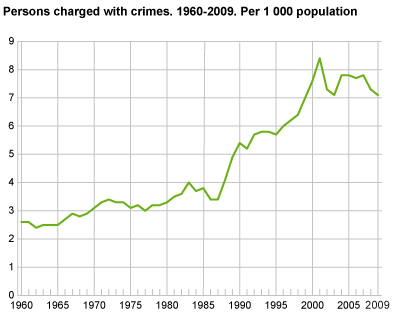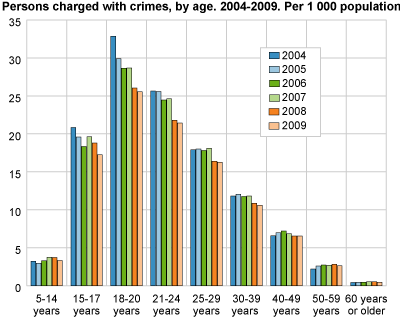Content
Published:
This is an archived release.
Fewer solved offences
More than 374 000 offences were completely investigated in 2009. In the criminal cases completed during the year, 172 000 offences are considered as solved, which resulted in 82 800 persons charged.
The police and the prosecution authority completed the investigation of more than 260 000 crimes and 114 000 misdemeanours in 2009. Compared to the previous year, almost 6 per cent fewer offences of narcotics and slightly more than 7 per cent fewer traffic misdemeanours were investigated. Additionally there are 4 per cent less offences in the category “Other crime”, which relates to the decreases in the number of misdemeanours against public order and peace (8 per cent), police regulations (14 per cent) and alcohol legislation (21 per cent).
Fewer offences reported by the police led to lower clear-up rates
A relatively large proportion of offences of narcotics and traffic offences, as well as the aforementioned categories of minor disorderly conduct, are offences without direct victims (see Victims of offences reported to the police ). These categories of offences are mainly reported as a result of active fieldwork by the police, and nearly all investigated offences in 2009 are offences reported in the same year (70 per cent) or the preceding year (24 per cent). The relatively low number of offences reported by the police is partially caused by the reduced level of activity in some of the police districts - in the period from late 2008 to the first half of 2009 (see also Offences reported ).
These offences are usually solved when discovered and reported - and have a clear-up rate between 76 and 93 per cent in 2009. The decline in offences reported by the police, together with the increase in the number of unsolved offences for profit, contributes to a total clear-up rate for offences (46 per cent) and crimes (32 per cent) that is considerably lower than the five preceding years. This, in turn, also explains why there has been a decrease in the total clear-up rate for crimes in as much as 23 of a total of 27 police districts from 2008 to 2009.
More offences for profit, but fewer solved
In total, the investigation of 176 000 offences for profit were completed during 2009, which is 5 per cent more than in 2008. There are particularly more of simple larceny (7 per cent) and petty larceny (13 per cent) in 2009 than in 2008. The number of aggravated larceny is also slightly higher in 2009 than in 2008 - about 3 per cent. However, the total percentage of solved offences for profit, and for most of the specified categories of larcenies, is lower in 2009 than in 2008 - a tendency observed during recent years. In total, 14 000 solved thefts in 2009 is the lowest amount registered since the beginning of the 1980s.
More persons charged with shoplifting
Related to the principal offences, almost 16 300 persons were charged with theft or other offences for profit, which is approximately 2 per cent more than in 2008. In total, there were almost 17 per cent more persons charged for petty larceny or simple larceny from shops as principal offence in 2009 than in 2008 - or close to 1 000 more persons. For most other categories in which larceny was the principal offence, the number of charged persons declined from 2008 to 2009.
A lower share of charged persons in all ages
A total of 3.6 per cent fewer persons were charged in 2009 than in the preceding year. There is a considerable decrease in the number of charged persons for only misdemeanours, particularly traffic misdemeanours (5 per cent fewer). The number of persons charged with crimes also decreased by 2 per cent. On the other hand, with regard to crime of narcotics as the principal offence, 2 per cent more persons were charged in 2009 than in 2008. However, this does not imply that the total number of persons charged with a narcotics crime increased, but rather indicates changes in the mix of charges within this group of offenders.
In total, the number of charged persons has decreased for all age categories, and for men and women. Related to the population growth, the decreases appear to be even higher. Particularly among persons aged 15-24 years the proportion of charged persons has declined considerably. This reduction is apparently a trend over a longer period in recent years (see figure).
Increased share of charged with foreign citizenship
More than 14 400 persons charged with offences in 2009, or more than 17 per cent of all, did not have Norwegian citizenship. This proportion is considerably higher than in the years 2003-2006, in which the share was stable at a level of around 14 per cent. The number of foreign citizens in Norway has increased considerably recently, particularly in the aftermath of the EU expansion in 2004 (compare the Population statistics ). The number of persons charged with citizenship from European countries has also increased in the crime statistics during the preceding years, especially for those with citizenship from outside the Nordic countries - which has increased from slightly more than 4 200 persons charged in 2005 to nearly 6 900 persons charged in 2009. Compared to the five preceding years, there were somewhat more charged persons in 2009 with citizenships from African countries. However, the number of charged persons with citizenships from other Nordic and Asian countries has been relatively stable in the years 2004-2009.
Different backgrounds and different offences
There are major differences in type of offences among persons charged with different citizenship. For instance, 70 per cent of persons charged with citizenship from other Nordic countries, Germany, Poland, Latvia and Estonia are only charged with misdemeanours. This share is considerably higher compared with persons charged with citizenship from other countries, including Norway (58 per cent). On the other hand, the share of charged persons with crimes is relatively high among the charged persons with citizenship from most African countries (67 per cent). This is partly due to the larger share of persons charged with offences of narcotics.
In 2009, more than 24 per cent of all persons charged with thefts, petty larceny or other offences for profit as there principal offence, did not have Norwegian citizenship. The share with foreign citizenship among persons charged with offence of narcotics and traffic offences has increased relatively steadily in recent years - from around 11 per cent in both categories in 2002, to 18 and 16 per cent respectively in 2009.
Many charged persons with recidivism
The statistics of recidivism among residents in Norway indicate that almost half of the more than 78 000 charged persons in 2004 were charged one time or more during the subsequent five year period. Two thirds of the total number of persons charged with offences of narcotics as their principal offence, were charged with one or more offences in the year 2005-2009. Classified by type of principal offence, the highest rate of recidivism, with more than 80 per cent, was among those with more serious types of theft and robbery as principle offence.
Among men aged 15-17 years, 67 per cent were charged again during the subsequent five year period. As for earlier years, the share with recidivism is reduced considerably with rising age among men, while the share with recidivism increases up to the age group 30-39 years among women - where it is at its highest with 39 per cent.
Statistics on investigated offences 2006-2010Statistics Norway has from the 2006 statistics made some adjustments in the processing routines of the basis data, in cooperation with the National Police Computing and Material Service and the Ministry of Justice and the Police. These adjustments do not imply any fundamental changes compared to earlier statistics. The 2010 statistics are expected to be completed by the end of 2011. |
Contact
-
Reid Jone Stene
E-mail: reid.jone.stene@ssb.no
tel.: (+47) 99 02 22 01
-
Siri Fjærtoft Fossanger
E-mail: siri.fossanger@ssb.no
tel.: (+47) 99 72 49 27
-
Sigmund Book Mohn
E-mail: sigmund.mohn@ssb.no
tel.: (+47) 94 32 77 22



